Enhanced TDS
Identification & Functionality
Features & Benefits
- Ready-to-Use Product Features
- Product Features
- Temperature resistant to 150℃
- Excellent resistance to most common chemicals
- Non flowing paste for ease of application
- Gap filling
- Bonds metals and reinforced composites such as GRP and GRE
- Good performance after cure at ambient temperature
- Application filed for KIWA potable water approval
- Properties further enhanced by postcuring
- Product Properties
- Temperature resistant to 150°C
- Excellent resistance to most common chemicals
- Non flowing paste for ease of application
- Gap filling
- Bonds metals and reinforced composites such as GRP and GRE
- Good performance after cure at ambient temperature
- Application filed for KIWA potable water approval
- Properties further enhanced by postcuring
Applications & Uses
- Application Area
- Compatible Substrates & Surfaces
- Markets
- Applications
- Processing Information
Pretreatment
The strength and durability of a bonded joint are dependent on proper treatment of the surfaces to be bonded. At the very least, joint surfaces should be cleaned with a good degreasing agent such as acetone or other proprietary degreasing agents in order to remove all traces of oil, grease and dirt. Low-grade alcohol, gasoline (petrol) or paint thinners should never be used. The strongest and most durable joints are obtained by either mechanically abrading or chemically etching (“pickling”) the degreased surfaces. Abrading should be followed by a second degreasing treatment
Application of adhesive
The resin/hardener mix is applied directly or with a spatula, to the pretreated and dry joint surfaces. The joint components should be assembled and clamped as soon as the adhesive has been applied. An even contact pressure throughout the joint area will ensure optimum cure
Mechanical processing
Specialist firms have developed metering, mixing and spreading equipment that enables the bulk processing of adhesive. We will be pleased to advise customers on the choice of equipment for their particular needs.
Equipment maintenance
All tools should be cleaned before adhesives residues have had time to cure. The removal of cured residues is a difficult and time-consuming operation. If solvents such as acetone are used for cleaning, operatives should take the appropriate precautions and, in addition, avoid skin and eye contact.
Typical times to minimum shear strength
Temperature °C 12 25 40 60 Cure time to reach
Lap shear strength > 1 MPahours 7 3 1 minutes 15 Cure time to reach
Lap/shear strength>10 MPahours 15 4 1 1/2 minutes 30 - Preprocessing Information
Pretreatment
The strength and durability of a bonded joint are dependent on proper treatment of the surfaces to be bonded. At the very least, joint surfaces should be cleaned with a good degreasing agent such as acetone or other proprietary degreasing agents in order to remove all traces of oil, grease and dirt.
Low-grade alcohol, gasoline (petrol) or paint thinners should never be used.
The strongest and most durable joints are obtained by either mechanically abrading or chemically etching (“pickling”) the degreased surfaces. Abrading should be followed by a second degreasing treatment- Product Applications
Application of adhesive
- The resin/hardener mix is applied directly or with a spatula, to the pretreated and dry joint surfaces.
- The joint components should be assembled and clamped as soon as the adhesive has been applied.
- An even contact pressure throughout the joint area will ensure optimum cure.
Mechanical processing
- Specialist firms have developed metering, mixing and spreading equipment that enables the bulk processing of adhesive.
- We will be pleased to advise customers on the choice of equipment for their particular needs.
Properties
Technical Details & Test Data
- Typical Cured Properties
- Unless otherwise stated, the figures given below were all determined by testing standard specimens made by lapjointing 114 x 25 x 1.6 mm strips of aluminium alloy.
- The joint area was 12.5 x 25 mm in each case.
- The figures were determined with typical production batches using standard testing methods.
- They are provided solely as technical information and do not constitute a product specification.
Average lap shear strengths of typical metal-to-metal joints (ISO 4587) (typical average values)
Cured for 24 hours at 23°C + 4 hours at 120°C and tested at 23°C - Pretreatment - Sand blasting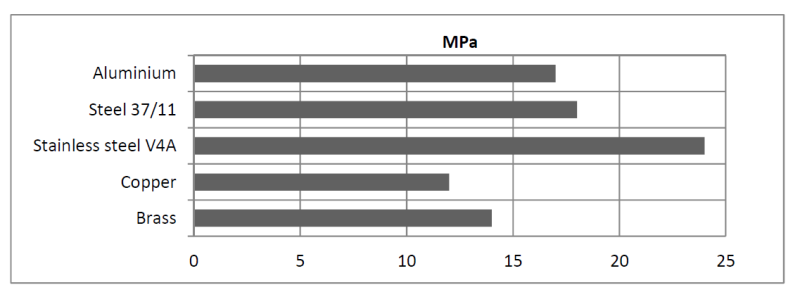
Average lap shear strengths of typical plastic-to-plastic joints (ISO 4587) (typical average values)
Cured for 24 hours at 23°C + 4 hours at 80°C and tested at 23°C
Pretreatment - Lightly abrade and alcohol degrease.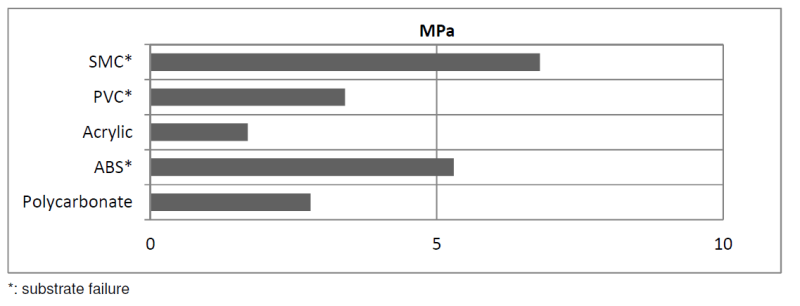
Average lap shear strengths of typical composite-to-composite joints (ISO 4587) (typical average values)
Cured for 24 hours at 23°C + 4 hours at 120°C and tested at 23°C
Pretreatment - Lightly abrade and alcohol degrease.
Lap shear strength versus temperature (ISO 4587) (typical average values)
Cure: 24 hours at 23°C + 4 hours at 120°C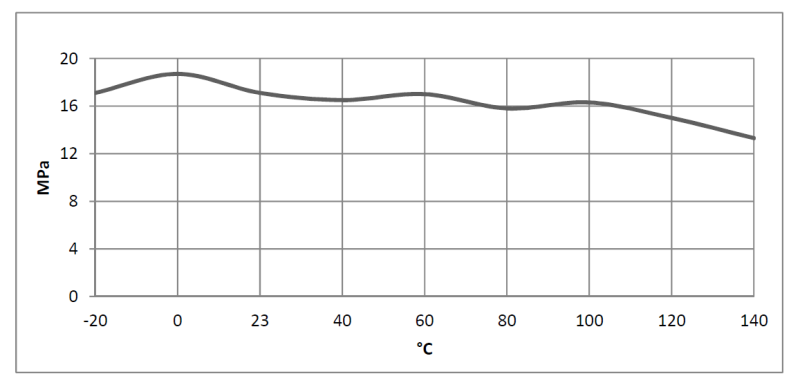
Roller peel test (ISO 4578) (typical average values)
Substrate: AluminiumCured 7d at 23°C - 2.6 N/mm
Cured 7d at 23°C + 1 hour at 80°C - 4.6 N/mm
Cure 7d at 23°C + 1 hours at 125°C - 5.6 N/mmLap shear strength versus immersion in various media (typical average values)
Unless otherwise stated, L.S.S. was determined after immersion for 90 days at 23°C
Cure: 24 hours at 23°C + 1 hour at 130°C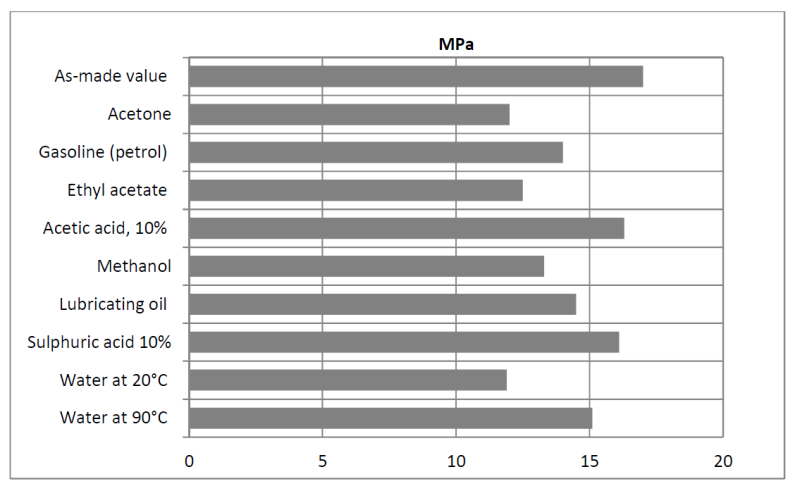
Lap shear strength versus tropical weathering (typical average values)
(40/92, DIN 50015; typical average values)
Cure: 24 hours at 23°C + 4 hours at 120°C and tested at 23°C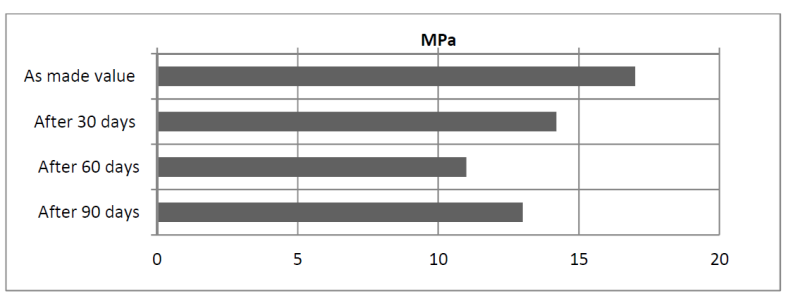
Lap shear strength vs. water immersion on GRE (typical average values)
Cure: 7 days at 23°C + 4 hours at 120°C – overlap 25mm x 15mm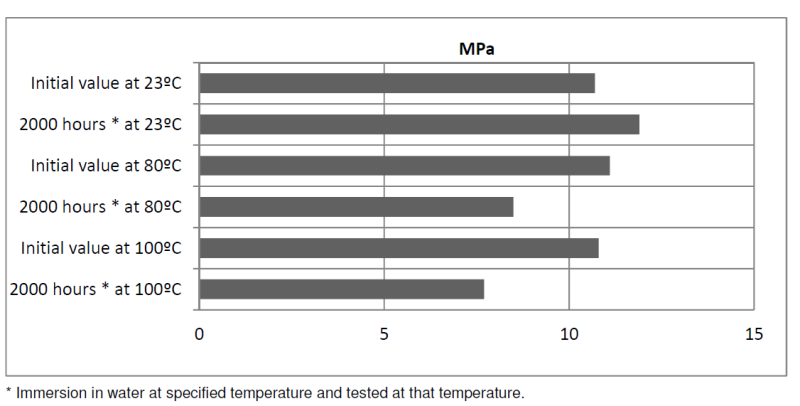
- Typical Cured Properties
Unless otherwise stated, the figures given below were all determined by testing standard specimens made by lapjointing 114 x 25 x 1.6 mm strips of aluminium alloy. The joint area was 12.5 x 25 mm in each case. The figures were determined with typical production batches using standard testing methods.
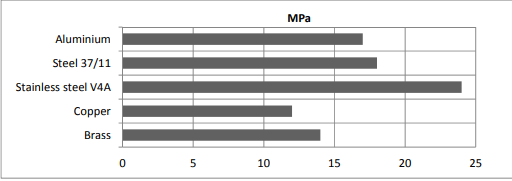
Average lap shear strengths of typical metal-to-metal joints (ISO 4587) (typical average values) Cured for 24 hours at 23°C + 4 hours at 120°C and tested at 23°C - Pretreatment - Sand blasting
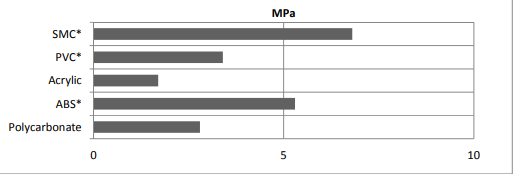
Average lap shear strengths of typical plastic-to-plastic joints (ISO 4587) (typical average values) Cured for 24 hours at 23°C + 4 hours at 80°C and tested at 23°C Pretreatment - Lightly abrade and alcohol degrease

Average lap shear strengths of typical composite-to-composite joints (ISO 4587) (typical average values) Cured for 24 hours at 23°C + 4 hours at 120°C and tested at 23°C Pretreatment - Lightly abrade and alcohol degrease
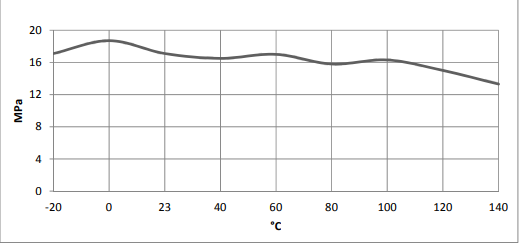
Lap shear strength versus temperature (ISO 4587) (typical average values) Cure: 24 hours at 23°C + 4 hours at 120°C
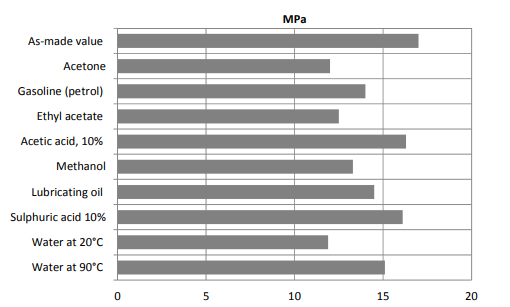
Lap shear strength versus immersion in various media (typical average values) Unless otherwise stated, L.S.S. was determined after immersion for 90 days at 23°C Cure: 24 hours at 23°C + 1 hour at 130°C
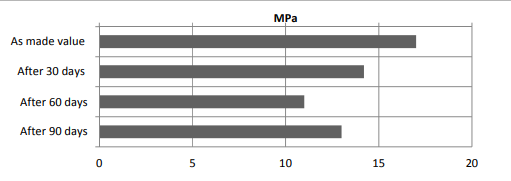
Lap shear strength versus tropical weathering (typical average values) (40/92, DIN 50015; typical average values) Cure: 24 hours at 23°C + 4 hours at 120°C and tested at 23°C
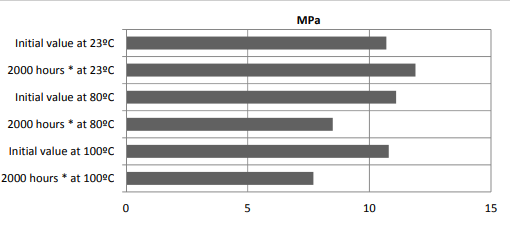
Lap shear strength vs. water immersion on GRE (typical average values) Cure: 7 days at 23°C + 4 hours at 120°C – overlap 25mm x 15mm
Roller peel test (ISO 4578) (typical average values)
Substrate: Aluminium Cured 7d at 23°C 2.6 N/mm Cured 7d at 23°C + 1 hour at 80°C 4.6 N/mm Cure 7d at 23°C + 1 hours at 125°C 5.6 N/mm - Equipment Maintenance
- All tools should be cleaned before adhesives residues have had time to cure.
- The removal of cured residues is a difficult and time-consuming operation.
- If solvents such as acetone are used for cleaning, operatives should take the appropriate precautions and, in addition, avoid skin and eye contact.
- Typical Times to Minimum Shear Strength
Temperature (°C) 15 25 40 60 Cure time to reach Lap shear strength > 1 MPa (hours) 7 3 1 - Cure time to reach Lap shear strength > 1 MPa (minutes) - - - 15 Cure time to reach Lap shear strength > 10 MPa (hours) 15 4 1.5 - Cure time to reach Lap shear strength > 10 MPa (minutes) - - - 30 Good properties are obtained after ambient temperature curing, but in order to achieve optimum performance properties an elevated temperature cure or post-cure is recommended. Suggested post-cure schedules are: 2hrs at 80°C or 1 hr at 120°C or by post-curing in service
Safety & Health
- Handling Precautions
- Our products are generally quite harmless to handle provided that certain precautions normally taken when handling chemicals are observed.
- The uncured materials must not, for instance, be allowed to come into contact with foodstuffs or food utensils, and measures should be taken to prevent the uncured materials from coming in contact with the skin, since people with particularly sensitive skin may be affected.
- The wearing of impervious rubber or plastic gloves will normally be necessary; likewise the use of eye protection
- The skin should be thoroughly cleansed at the end of each working period by washing with soap and warm water.
- The use of solvents is to be avoided. Disposable paper - not cloth towels - should be used to dry the skin. Adequate ventilation of the working area is recommended.
Packaging & Availability
- Regional Availability
Storage & Handling
- Storage Conditions
Araldite® AV 4738 and Hardener HV 4739 must be stored at room temperature and the components must be stored in sealed containers. The expiry date is indicated on the label.
- Storage Information
ARALDITE® AV 4738/HV 4739 must be stored at room temperature, and the components must be stored in sealed containers.
- Handling Information
- Our products are generally quite harmless to handle provided that certain precautions normally taken when handling chemicals are observed.
- The uncured materials must not, for instance, be allowed to come into contact with foodstuffs or food utensils, and measures should be taken to prevent the uncured materials from coming in contact with the skin, since people with particularly sensitive skin may be affected.
- The wearing of impervious rubber or plastic gloves will normally be necessary; likewise the use of eye protection.
- The skin should be thoroughly cleansed at the end of each working period by washing with soap and warm water.
- The use of solvents is to be avoided. Disposable paper - not cloth towels - should be used to dry the skin.
- Adequate ventilation of the working area is recommended.
Other
- Appearance
- Grey paste
- Application Information
Value Units Test Method / Conditions Mix Ratio 0.25-0.275 %(W) Hardener : Resin - Physical Properties
Value Units Test Method / Conditions Density approx. 1.6 g/cm³ Internal Method at 25°C Gel Time 40.0-50.0 m Internal Method at 40°C Glass Transition Temperature (Tg) 120.0 °C Internal Method Lap Shear Strength min. 10.0 MPa Internal Method at 23°C Viscosity 40.0-50.0 Pa.s Internal Method at 25°C
